smoging 89 ford mustang what to look out for
The third generation Ford Mustang was introduced in 1979 and remained in product until 1993, amassing over 2.6 million cars produced. The new Mustang was based on the smaller of Ford's ii new unibody rear-wheel drive platforms, known internally by Ford as "the Play tricks."
This third generation Mustang became the clearest manifestation that the wimpy, low-compression, emissions-strangled cars of the 70s might evolve into the glorious second-coming-of-musculus that we are enjoying in the early 21st century. The Play a joke on Mustang represented "The Return of Operation," and while the horsepower figures don't advise massive performance today, what had returned from the late-60s was a specific experience, an mental attitude, and swagger.
1993 Ford Mustang SVT Cobra
The perfect trifecta of a good bones design, plentiful production, and a wide, deep supply of hotrod parts, make the Play a trick on-torso Mustang the ideal choice for an array of racing applications. Fox-body Mustangs were used in road racing during the 80s, and today they remain a popular selection in upkeep racing series like Champcar or 24 Hours of Lemons and for autocross. Depression-cost V8 power and the rear-wheel drive / alive axle set up make these excellent drift cars.
Due to its popularity, its high-production number is likely to ensure it'south long-term collectability: so many Americans know and beloved them.
Over the concluding 30 years, the 5.0 Play tricks has been the cheapest, fastest car you could buy. Almost have been raced, stolen, and wrecked – many more than once. They fabricated far more than Fox-body Mustangs than Mercedes SLs in the 80s, just today it is far easier finding a clean SL than v.0.
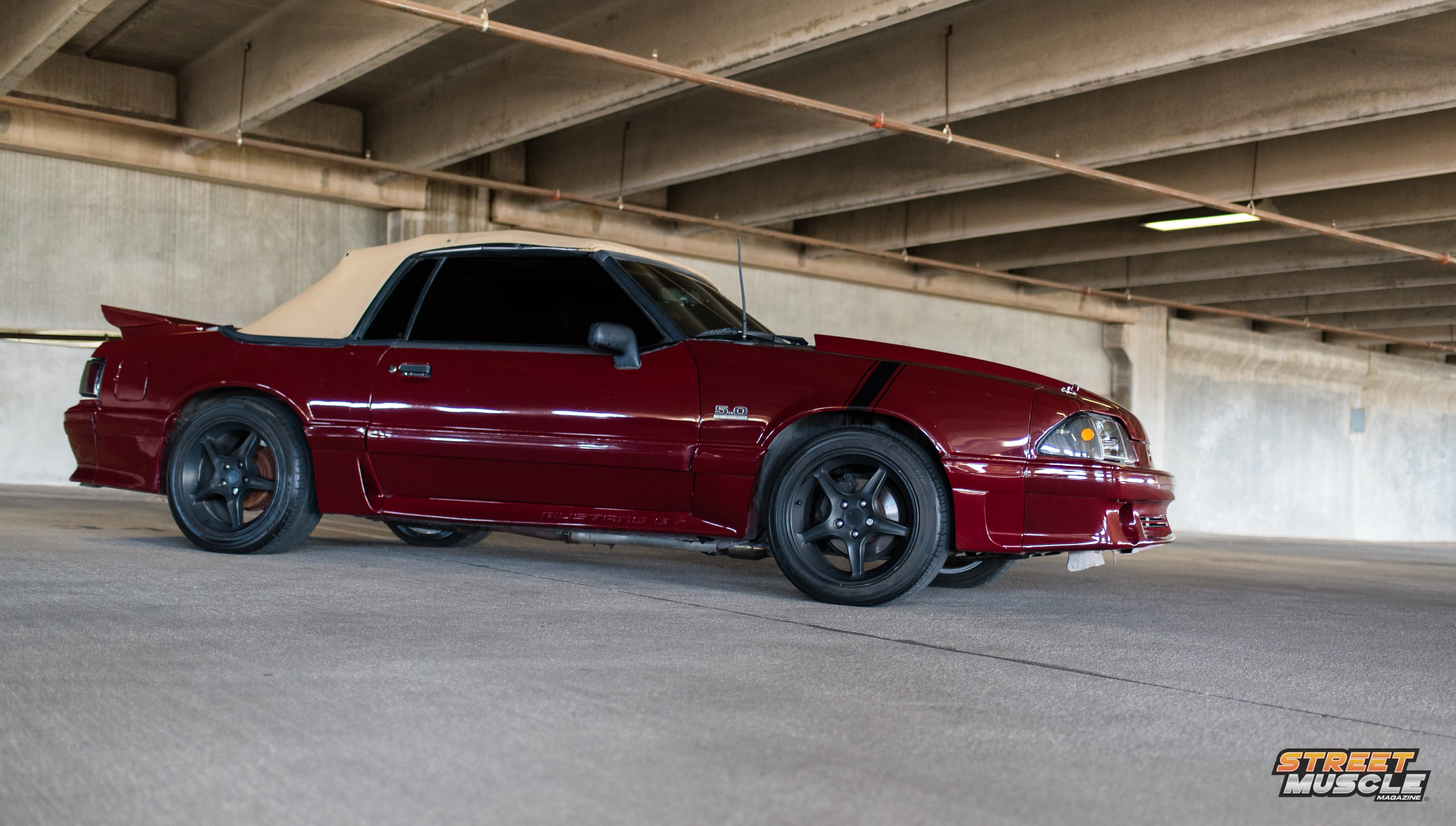
Modified 1989 5.0 Mustang convertible
What to Look For When Ownership?
Often called "Rustangs" by those living in the areas where its mutual to salt the roads, the Fox is no worse than its contemporaries when information technology comes to rust, only it remains an area of business when looking at cars from all climates. Be diligent while looking for crash impairment and race corruption. Presume the car has been wrecked, and look for evidence of where.
Begin with looking at the exterior – Is the paint fresh? Are the wheels original? Are the lights original? Many Flim-flam-body Mustangs take been modified by enthusiastic owners. Equally many take been wrecked and rebuilt, often inexpertly. Spotting details like original lights or the correct positioning of the "Ford" and "five.0" badges can give yous an idea of whether this example is original.
Shutlines – Await closely at the gaps between body panels. This is an excellent way to guess overall originality and bodily condition because uneven gaps propose replacement torso panels which, in turn, suggests blow damage. Remember that Fox Mustangs are non modernistic Toyotas, and thus poorly plumbing equipment hatchback body lids are to be expected.
A-pillars – Check the tops, they often crack due to body flex. While you're looking, run your easily down the A-pillar. It should be polish; waves or ripples may propose accident damage.
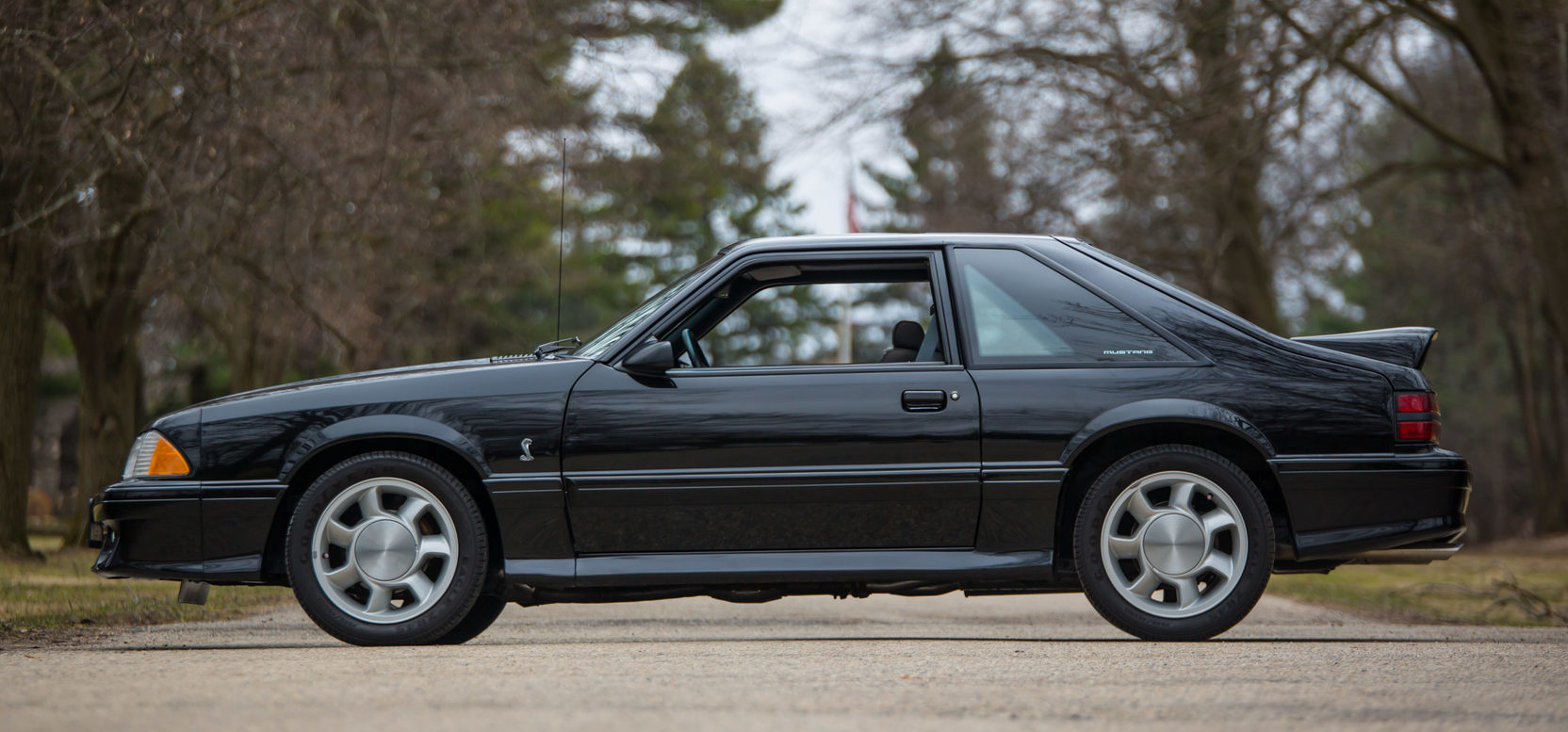
1993 Ford Mustang SVT Cobra
Doors – When closed, expect for sag by judging shut lines. When open up, check the hinges by pulling upwards on the open door; there should not be any play, although you will ofttimes find some. With the door open, reach inside the jamb between the hinges and bank check for rust.
Floors – While you lot're in the door jamb, lift the carpet behind the pedals and look for rust. Next look at where the seat base attaches to the body as this is as well a known rust spot.
Torso – Expect at both the notch and hatch for rust forth the leading edge. Be sure to check this every bit you open up the trunk.
Within – Look nether the rug on both sides and in the spare wheelwell, check for rust and ripples indicating accident damage.
Front Strut Towers – Look under the hood, check the front end strut towers for corrosion and crash damage. The tower should exist smooth; if the steel is rippled, information technology indicates serious accident harm. If they are seriously corroded, they are in danger of collapsing, something which is both unsafe and very difficult to repair.
Find where the framerail joins the struttower. With a flashlight, you should be able to see if information technology is repainted, if information technology is smooth, and if it has received bondo. If it has, it is likely the car sustained significant blow damage.
While you're intimate with the engine, take a look at the motor mounts too. While the parts themselves are pennies, the time and labor involved in replacing them is non.
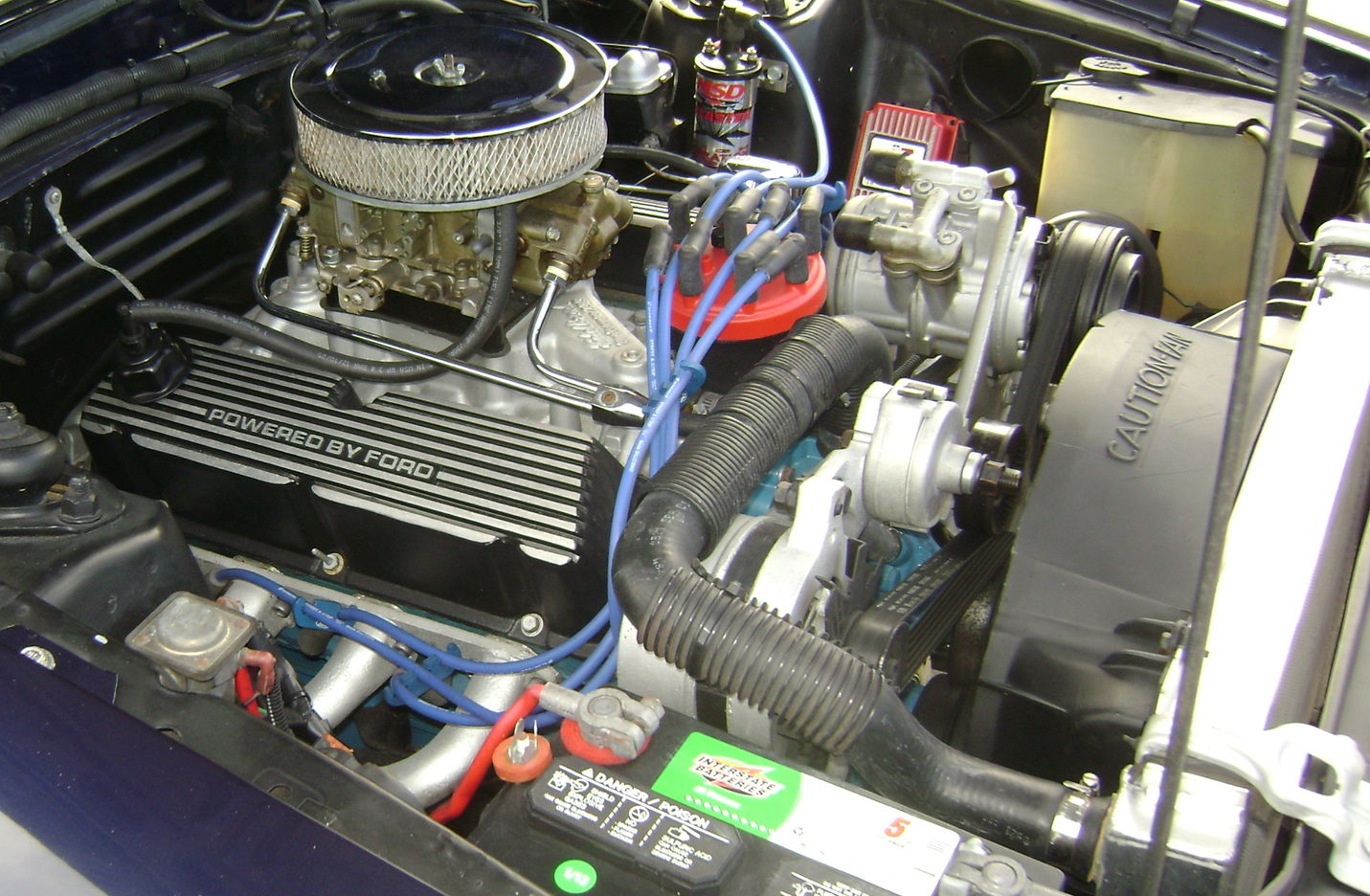
1982 Ford Mustang GT with 302 cubic-inch V8 topped with a 4-barrel Holley carburetor
Radiator Supports – While under the hood, the radiator supports are an first-class way to assure yourself if the auto has not been damaged in the front end. The supports should be straight and even; if they aren't, the front end of the automobile must have been bent at some point.
Underneath – Wait closely behind the front wheels and in front end of the rear wheels in addition to behind them. Dirt and moisture from the route tend to build up in these areas, causing rust. Wait for cracks or twisting in the torque boxes nearly the rear wheels. They are awkward to repair and are a certain sign of racing and other abuse. It is not uncommon to find a custom subframe connector welded on – good in that someone cared about the motorcar, merely likewise they were clearly racing information technology.
Different color body panels indicate a car made up of different bits following an accident bad plenty to require the replacement of diverse panels. A fender bender is just that – a new fender only. A mismatched fender/hood/door/bumper suggests 30 mph into a ditch and the likelihood of damage to the unibody structure. A good reason to walk abroad from the car, or negotiate a steep discount.
Engines
The fundamental simplicity and toughness of checking basic elements, like blue or white tailpipe smoke, is a critical task. Wait for under-the-hood originality, and know whether you are looking at Henry Ford'southward piece of work or that of Hotrod Harry'due south. Be mindful of the state smog rules the vehicle currently resides in. For example, much lower priced 5.0'due south run well just cannot pass smog in California. They neglect, considering part of the test specifically requires cars to appear factory-original under the hood. Fifty-fifty an afterward-market air filter is a smog fail unless the right CARB (California Air Resources Board) approved sticker is present.
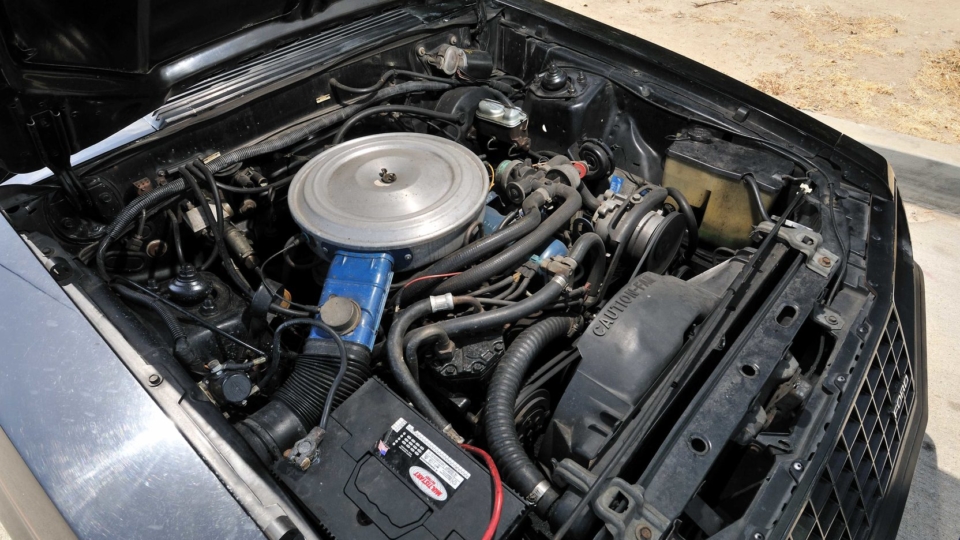
1980 Ford Mustang powered past "Police force Border" three.3-liter engine
1979-1988: 2.3-Liter Inline-4; 88 hp
More Trick Mustangs came with the humble 4-cylinder engine than any other engine blazon. Today, at that place are oftentimes unmolested, depression trim (hence lightweight) examples in clean, unmolested condition. These are of involvement if you lot're considering an engine bandy: drag racers fit Chevy LS motors, for example.
1984-1986: 2.three-liter Inline-4 Turbo; 175-205 hp
The limited-production Mustang SVO (Special Vehicle Operations) used the new, rapidly developing engineering of turbocharging aimed at what Ford's literature described as "the sophisticated driver." A unique double spoiler sat on the body lid and 5-lug wheels set up the SVO apart visually.
1979-1981: Inline-six; 90 hp
1981-1985: V6; 100 hp
Both 6 cylinder engines are rare, unloved and not extremely collectible.
1979-1993 4.9-liter V8; 140-225 hp
The legendary "V-Point-Oh," Ford'southward familiar Windsor pocket-sized-block V8, is potent and responsive to hot-rodding. While the raw power figures were good for the 80s it was the fat torque curve – 300 lb-ft, which gave the v.0 its character and charisma. Moving from carburetors to electronic fuel injection led to the introduction of roller cams and an increment in ability.
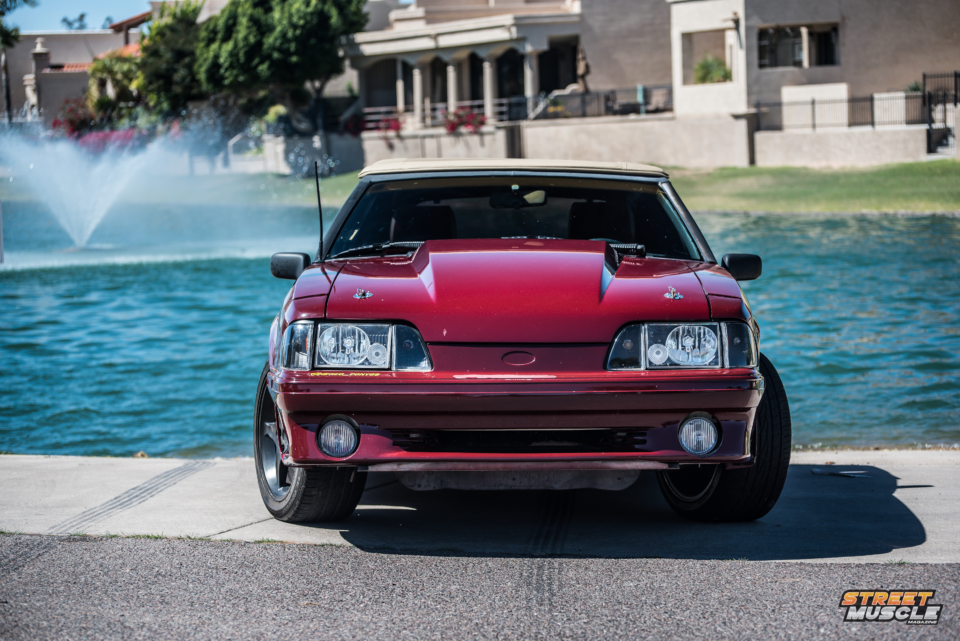
Transmission and Beam
In 1979, automatic Mustangs used the C4 3-speed transmission, then in 1982, they made the move to the C5 transmission, followed past a new 4-speed automatic overdrive gearbox in 1987. The manual transmission offered initially was a 4-speed until 1983 when they gained 5-speed transmissions.
Information technology is of import to check for fluid leaks on all input and output shafts to and from the gearbox and beam. While the components themselves are tough, leaks, especially from the rear main seal of the transmission, are common.
When parts go worn they cannot be easily repaired. In my feel, my 1987 5-speed Mustang would not keep oil in the gearbox due to play in the output shaft. Most of the oil seemed to leak out in the first 200 miles or and so. Speaking to the toughness, the gearbox continued to part, albeit with a more notchy character, whether it had oil in information technology or not.
Fox Mustangs were equipped with Ford'southward eight.viii-inch rear-axle. Check information technology for leaks from the differential casing, and for the whine, especially when they are over-run, when y'all step on the gas, and when you lot brainstorm to slow down.
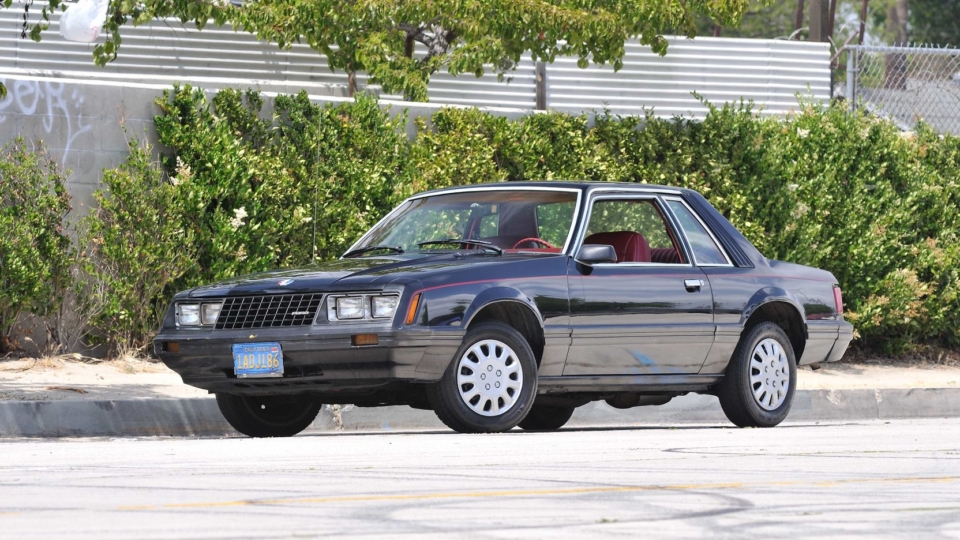
1980 Ford Mustang
Brakes
Pull a fast one on-trunk Mustangs use a combination of front-disc brakes and rear-drum brakes. While this was perhaps adequate in an era of mullets, in comparison to modern cars, the brakes can feel quite weak. For this reason, many cars have warped front rotors, which is something to check on your test drive: suspension from high speed and see if you feel a pulsing from the brake pedal.
"I skilful press, then you're washed" commented ane leadfoot interviewed for this piece, and while that may be an exaggeration, brakes are a limiting cistron in route and autocross functioning.
It is possible to experiment with pads and rotors to meliorate performance, but really the problem can only be solved by irresolute to the five-lug cycle hubs constitute on SN95 Mustangs, since the bigger wheels let the fitting of bigger brakes. It should be emphasized that the brakes aren't terrible, information technology is merely all-time to utilize the brakes and transmission together to become the car stopped, like a 60s muscle car.
Interior
Flim-flam Mustang interiors are cloth, plastic, and vinyl, and what they lack in style they make upwardly for in practicality. Although originally pretty tough, 30 years has left some looking very tired indeed.
Seats are often greasy, carve up, and collapsed, leaving you feeling similar you're sitting on the floor. The inner sides of the seats tend to collapse, giving even your mom a "Gangsta Lean." Headliners are typically cigarette burned or dirty, even on otherwise tidy examples, and the map lights rarely work. It is rarer however to find a Fox Mustang ashtray door which will actually remain closed.
Odometers have just five digits, pregnant that when the motorcar passed 100,000 the odometer returned to nothing. Moreover, the Play a trick on Mustang instrument binnacles are easily replaced, and not that reliable in the offset identify. Taking these things together, it becomes articulate that the number on the odometer is very, very unlikely to accurately reflect the bodily miles on the automobile, despite any the seller may believe.
Interior
At that place are various fundamental touch points to look at to assess 18-carat wear and mileage.
For example, the pedals should show clothing consequent with the mileage and with other parts of the interior. Make new rubbers on an "original 75,000-mile" auto suggest 175,000 miles, and the originally worn rubbers being replaced.
If you have 1, bring your OBD2 scan tool. If the car yous're looking at is showing a Check Engine light, you lot tin can plug it in and pull a code right there, allowing you to swiftly determine what is wrong, and thus whether yous desire the machine or not.
Look at the radio slot. Many Foxes had aftermarket stereos, speakers, alarms, and immobilizers fitted. Information technology is like shooting fish in a barrel for that equipment and wiring to become bad, leading to endless frustrating electric gremlins. Fitting this kind of device oft damaged door cards and bundle shelves as well.
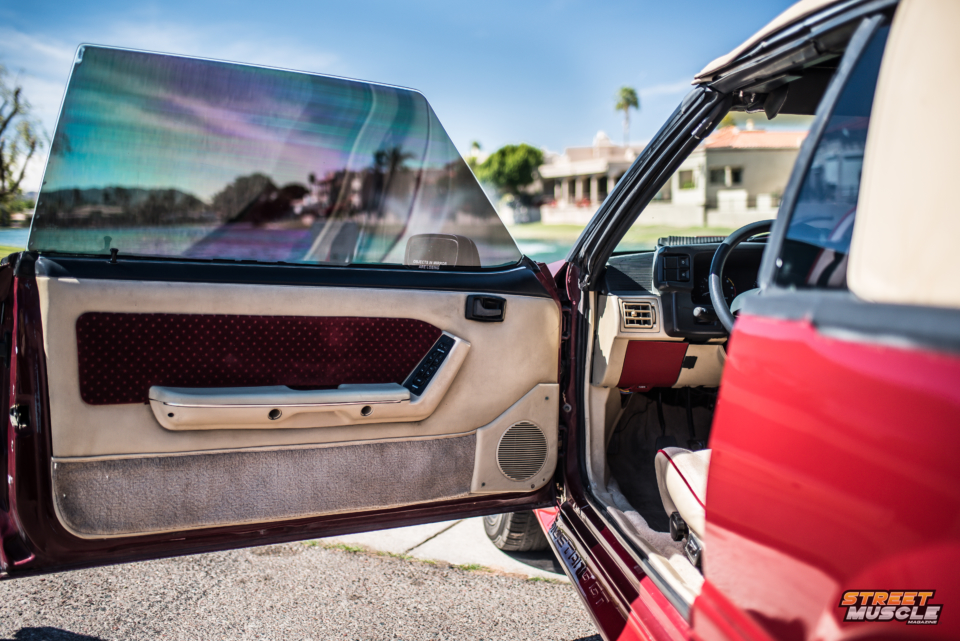
Styling and Model Range
Stung by criticism of the Mustang II, Ford returned to the long hood/short deck format for the Fox. The traditional three-box shape notchback was offered and the convertible made a return to sit alongside the hatchback design introduced with Mustang Ii. The broad range of trim and options show how Mustang could equally be muscle as grocery-getter.
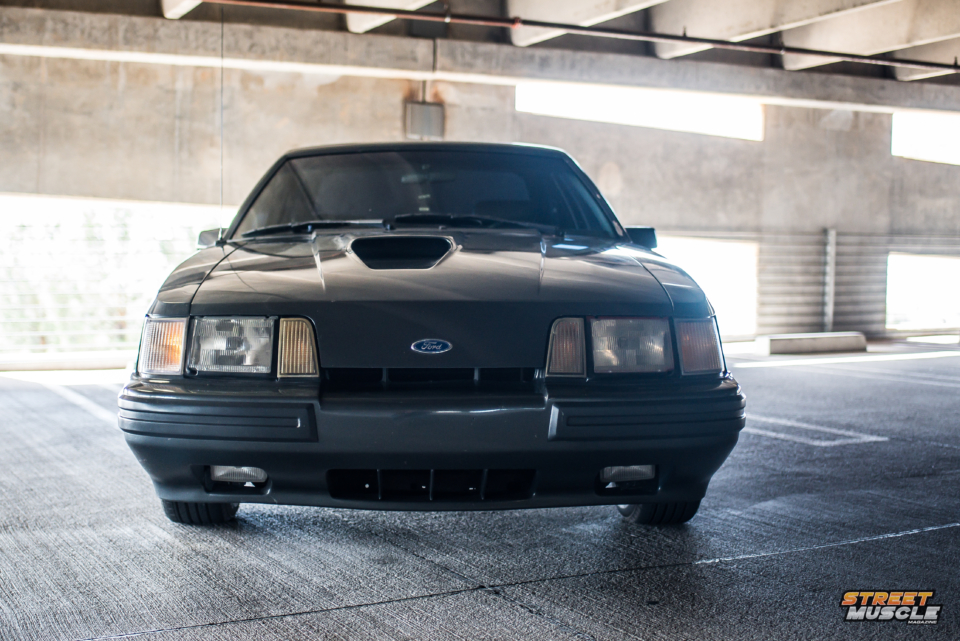
1986 SVO Mustang powered by a 2.3-liter turbo
Early generation examples are known as "4 Optics" due to the distinctive quad headlight olfactory organ. These were available in base, Ghia, and Cobra trim. In 1982, Cobra became GT. Midway through the model cycle, in 1987, the Fox was given a facelift, four eyes giving way to ii, without a grille, similar to the "aero" look seen on the SVO. Trim levels were Lx and GT only, and while LX represented entry level information technology could still exist had with the V8. GTs all had V8s and body kits which shout "the 1980s" like Miami Vice or Donna Karan.
Alternatives:
1982-1992 Third Generation Camaro
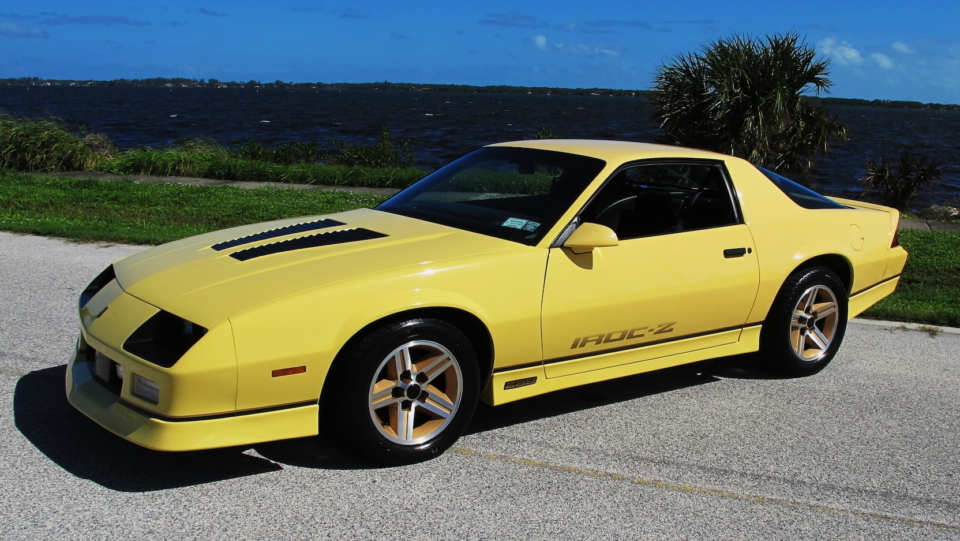
1986 Chevrolet Camaro Iroc-Z
Like in character to the Mustang, only like it's sixties brother belatedly to the political party, the Full general's try to incorporate European styling into American muscle was arguably nicer to look at than the Fox. The range of models and engine options is similar in character to the Fox, with Street Muscle readers probably being most interested in the high-performance IROC-Z (International Race of Champions) and Z-28.
1989 – Present Mazda Miata
Every bit a ii-seat roadster which barely overlapped Play a joke on Mustang production, the Miata is not the same thing at the Flim-flam Mustang, however, it deserves mention here since information technology is the only thing with a similar blindside for the buck as a Trick or a tertiary gen Camaro.
Resource
Parts Suppliers, Specialists, and Forums
The breadth of this kind of support massively improves collectibility.
- Late Model Registry
- Mustang Lab
The Street Muscle Sum Up
The simplicity and strength of the Play a joke on Mustang's mechanicals and the 5.0, in particular, make upwards a large role of their entreatment. Their size and weight centrolineal with the huge aftermarket makes them attractive to collectors and racers of all types, while the driving experience is familiar even so satisfying similar hamburger and fries. If you take read this far, and think you might similar a Pull a fast one on, become out and buy i before long: prices are ascension, just are nowhere nigh the levels of sixties muscle. Nonetheless.
Photography provided by Mecum Auctions and Nicole Ellan James
Source: https://www.streetmusclemag.com/features/what-to-look-for-when-buying-a-fox-body-mustang/
0 Response to "smoging 89 ford mustang what to look out for"
Post a Comment